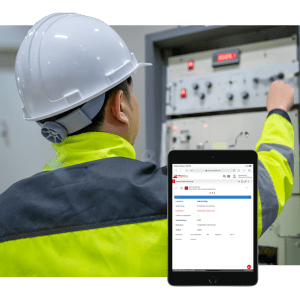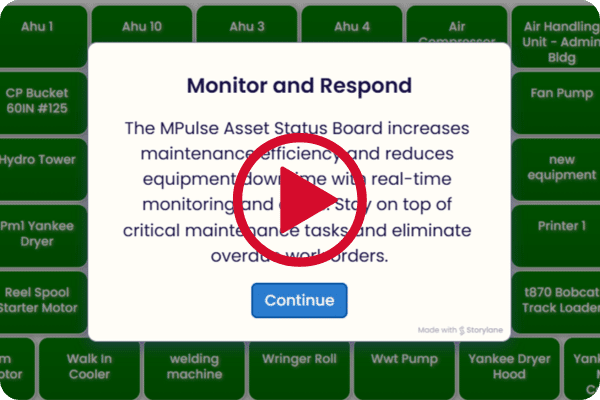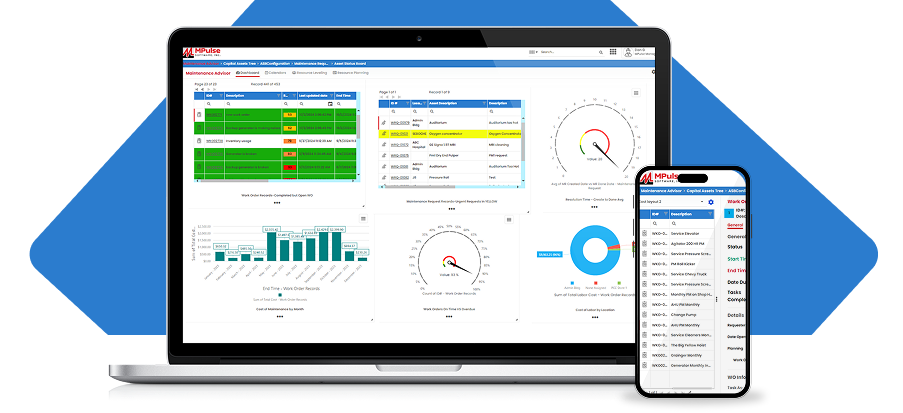
Failure Reporting, Analysis, and Corrective Action System
FRACAS, or Failure Reporting, Analysis, and Corrective Action System, is a structured process for identifying, analyzing, and resolving equipment failures. By addressing root causes and implementing corrective actions, FRACAS helps reduce downtime, extend asset lifecycles, and lower costs. With MPulse, you can streamline your maintenance strategy and enhance operational reliability.
Table of Contents
What is a FRACAS?
FRACAS stands for Failure Reporting, Analysis, and Corrective Action System. It’s a closed-loop system designed to help maintenance teams identify, respond to, and resolve the root causes of asset failure. A FRACAS includes three primary components:
Failure Reporting: Identifying all the ways an asset has failed or could fail.
Failure Analysis: Investigating the causes of asset failure.
Failure Correction: Taking action to address the failure and prevent it from recurring.
By leveraging historical equipment performance data, a FRACAS optimizes the asset lifecycle, supporting decisions on how to design, operate, maintain, and dispose of assets.
What is the FRACAS Loop?
The FRACAS loop is a structured, continuous process for implementing a failure reporting, analysis, and corrective action system. Each step provides a framework for identifying, analyzing, and addressing asset failures. The loop is ongoing, ensuring that organizations consistently uncover, learn from, and address failures.
The FRACAS loop consists of five key steps:
1. Failure Mode and Effects Analysis (FMEA)
An FMEA is a detailed list of potential equipment failures, their impacts, possible causes, and recommended actions. It prioritizes action based on asset criticality, the frequency and severity of failures, and repair resources. As new failure patterns emerge, FMEAs are updated to reflect trends.
2. Failure Code Creation
Failure codes are concise descriptions of asset failures, typically comprising three elements: component, defect, and cause. For instance, a failure code for a variable speed conveyor might be: Bearing, wear, lack of lubrication. Failure codes help organize, track, and analyze failure data, enabling proactive planning to eliminate recurring issues.
3. Work Order Analysis
Work order analysis identifies common failures by reviewing failure codes in work order notes. This process highlights recurring problems, determines focus areas, and creates a baseline to measure corrective actions.
4. Root Cause Analysis (RCA)
Root cause analysis dives deeper than immediate causes to identify the underlying reasons for asset failure. For example, the immediate cause of a bearing failure might be a lack of lubrication. However, an RCA might uncover that unclear instructions or inadequate training caused the lubrication issue. RCA eliminates failure at its source to prevent recurrence.
5. Strategy Adjustment
Insights from the previous steps are used to implement changes that reduce failures. For example, if a bearing fails repeatedly due to mislabeled lubrication, the strategy might include creating a new labeling system and providing training on it. Updates to the FMEA reflect these adjustments, ensuring the loop continues effectively.
Examples of a FRACAS in Maintenance
Reducing repair costs: After analyzing failure codes and conducting an RCA, you discover equipment failures linked to using old parts for repairs. Highlighting the cost of these failures helps secure a higher inventory budget, eliminating the issue.
Adapting to new conditions: Equipment failures increase after introducing a new product line. A FRACAS investigation reveals the new product specs affect machine setup. Implementing a process to communicate such modifications reduces downtime across sites.
Focusing resources: A failure report identifies three common issues, but resources are limited. By analyzing FMEAs, cost reports, and RCAs, you identify the most critical failure to address first, securing the necessary budget to tackle other failures later.
Benefits of implementing FRACAS
What are the benefits of implementing FRACAS? Think of it as asking, “What are the advantages of a reliable and efficient maintenance system?” The benefits are substantial and transformative:
Reduced Total Cost of Ownership (TCO):
With fewer breakdowns, your production system becomes far more cost-effective. FRACAS helps minimize spending on spare parts, reduces labor costs, and extends the useful life of your equipment.Increased Asset Availability:
Greater operational availability creates opportunities for additional revenue by accommodating more clients or increasing production output. This also reduces the production cost per unit by spreading equipment costs over larger product quantities, improving profit margins.Enhanced Customer Satisfaction:
Reliable equipment ensures production schedules are met, maintaining quality standards and delivery timelines. This builds trust, strengthens client relationships, and boosts customer retention.Improved Regulatory Compliance:
Equipment failure can compromise employee safety and lead to environmental non-compliance. FRACAS enables controlled, planned shutdowns and proactive interventions, reducing the need for unplanned, high-risk emergency repairs.Lower Scrap Rates and Warranty Claims:
Failures and degraded equipment can produce defective products, leading to rework or warranty claims. By improving reliability, FRACAS minimizes these occurrences, cutting costs and maintaining client satisfaction.
How to Gather Reliable Data for Your FRACAS
Accurate data is the foundation of an effective FRACAS. To ensure your system runs smoothly:
- Conduct spot checks: Regularly review your data to ensure accuracy without scrutinizing every work order.
- Engage your team: Talk to technicians to uncover obstacles in data collection and identify areas for improvement.
- Simplify processes: Make logging data easy and practical by removing unnecessary tasks or reworking ineffective processes.
Ask questions like:
- Is any task unnecessary or too frequent? Adjust or explain its importance.
- Are the expectations for data logging clear? Ensure alignment on what and how to measure.
- Is the process user-friendly? Identify and fix challenges to streamline data collection.
Bringing FRACAS to Life
By implementing FRACAS, your organization gains a powerful tool to improve equipment reliability, reduce costs, and enhance productivity. It’s time to take action and put failure reporting, analysis, and corrective actions into practice. With MPulse as your partner, you’ll have the tools and expertise needed to create a resilient, high-performing maintenance system.
Tips for Avoiding Common Mistakes with FRACAS
Implementing a complex system like FRACAS can present challenges. Avoid common pitfalls with these best practices:
1. Don’t Use Maintenance Tasks as a Default Corrective Action
Adding more maintenance tasks to prevent failures can bloat your maintenance program, driving up costs and reducing efficiency.
Better Approach: Address failures at their source through design modifications, equipment upgrades, or process changes. Maintenance tasks should be the last resort, not the first line of defense.
2. Avoid Over-Collecting Data
While it’s tempting to collect as much data as possible, overloading your FRACAS with unnecessary information makes it harder to identify actionable insights.
Focus on Priorities: Narrow your data collection to high-priority issues and use that data to monitor and solve critical problems.
3. Leverage Your CMMS
Your Computerized Maintenance Management System (CMMS) serves as the central hub for maintenance data and in-service history.
Automation is Key: Avoid creating parallel or manual FRACAS systems. A CMMS can streamline the process by automating data analysis, generating dashboards, and triggering alerts for failures.
4. Keep the System User-Friendly
Standardization and digitization are vital, but your employees are at the core of the FRACAS process.
Make it Simple: If the system is too complicated or burdensome, employees may cut corners or avoid using it. A successful FRACAS makes processes easier, not harder, for your team.
5. Share Success Stories
Highlight the achievements and benefits of your FRACAS system to keep employees engaged and motivated.
Build a Positive Feedback Loop: Regular updates on how FRACAS has improved reliability, reduced costs, or increased efficiency will reinforce its value and secure ongoing support across your organization.
MPulse Means Happy Customers










